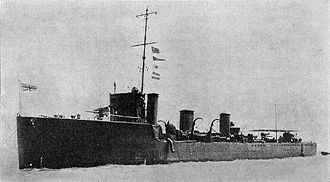 HMS Shark, lost at the Battle of Jutland | |
| Class overview | |
|---|---|
| Name | Acasta class |
| Operators | |
| Preceded by | Acheron class |
| Succeeded by | L class |
| Built | 1912–1913 |
| In commission | 1912–1923 |
| Completed | 20 |
| Lost | 7 |
| General characteristics | |
| Type | Torpedo boat destroyer |
| Displacement | 934 to 984 tons |
| Length | 267 ft 6 in (81.53 m) to 252 ft (76.8 m) |
| Beam | 26 ft 6 in (8.08 m) to 26 ft 9 in (8.15 m) |
| Draught | 9 ft 6 in (2.90 m) to 9 ft (2.7 m) |
| Installed power | 24,500 hp (18,270 kW) |
| Propulsion |
|
| Speed | 29 kn (53.7 km/h) - 32 kn (59.3 km/h) [1] |
| Complement | 75 - 77 |
| Armament |
|
The Acasta class (in September 1913 re-designated the K class) was a class of twenty destroyers built for the Royal Navy under the Naval Programme of 1911 - 1912 that saw service during World War I. They were the last class of Royal Navy destroyers to have mixed names with no systematic theme (see naming conventions for destroyers of the Royal Navy for more information.) When the class was designated as "K", names beginning with that letter were allocated to the ships but never used. [Note 1] [4] The class saw extensive wartime service and seven were lost, including four at the Battle of Jutland.








